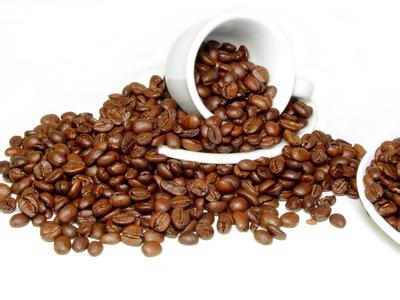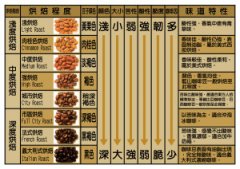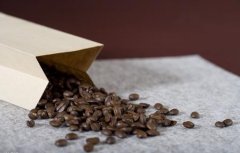Coffee Bean roasting Technology Coffee Roaster training Summary
The degree of heating of raw coffee beans is different, which will lead to changes in appearance colors such as brown to black. The index of heating degree is called baking degree. The baking degree is generally distinguished according to the color of the baked beans.

The roasting degree of coffee in Japan is generally in the following order: light roasting, cinnamon roasting, medium roasting, high roasting, urban roasting, deep city roasting, French roasting and Italian roasting.
These names come from Light, Cinamon, Medium, Medium high, City, Full city, French (Dark) and Italian (Heavy) in the United States. In the United States, there are also baking degree names such as New England (between Light and Cinamon), Viennese or Continental (between Full city and French), and Spanish (baking degree is deeper than Italian).
Roasting degree and flavor are always closely related, although there are differences in degree, but as long as each kind of coffee is roasted more deeply, the sour taste will be weakened and the bitter taste will be stronger. Therefore, the degree of roasting is one of the bases for understanding the taste of coffee. However, the taste created by the degree of baking is affected to some extent by the type of raw beans. If the coffee is grown in Congo, it will hardly taste sour even if it is roasted lightly. If the Arabica coffee is grown on the plateau, even if it is deeply roasted, it will still have a sour taste. In addition, the names such as light baking and moderate baking are only generally used to indicate the degree of baking, because these names depend on the subjective determination of the baker. It is not surprising that the roasting degree of city roasted coffee in one store is deeper than the French roasting in another store.
Coffee roasting is very interesting, easy to learn but not easy to go deep into. It is a field that is easy to learn but difficult to master.
Human beings have thousands of years of experience in wine and tea. however, human beings have known coffee for only a little more than 700 years.
Four words can aptly express the feeling I have explored in the field of coffee baking: "the blind touch the elephant". Once upon a time, I thought I had touched a specific shape, but it turned out to be nothing more than an elephant trunk. After a period of time, you may find that it is not all of the elephant trunk, but only a small part. The deeper you explore, the more you discover what you don't know and the more you don't understand.
Basically, coffee beans are very sensitive and meticulous in their response to baking, and as long as there are small differences in some environmental variables, they can have a significant or very significant impact. The roasting of coffee beans is difficult to quantify, whether in terms of baking degree, roasting type, or baking quality.
The professional knowledge about coffee bean roasting is very poor, and it is often filled with a sense of God and some secret recipes passed down by families. Compared with other areas of human knowledge, human beings are still in a relatively poor state in terms of the knowledge base of coffee roasting. The inheritance and education of professional coffee roasting is also very difficult. All sides are showing that this is not an easy way to go. On the way of learning coffee roasting, I must use rational thinking to make judgment and analysis (THINK) at any time, use perceptual perception system as assistant and judge (FEEL), and then repeatedly implement and verify (ROAST) in a large number of practical assignments. The circle of Think,Feel,Roast is always repeated, and the three may be carried out sequentially or at the same time and are equally important.
Important Notice :
前街咖啡 FrontStreet Coffee has moved to new addredd:
FrontStreet Coffee Address: 315,Donghua East Road,GuangZhou
Tel:020 38364473
- Prev

Roasting technology of coffee beans roasting methods of fine coffee
For a long time, the production of coffee has been improved by increasing the yield and reducing the difficulty of planting according to the economic factors. However, with the promotion of boutique coffee, the nature of coffee has also changed, from the trend of economic priority to allowing consumers to enjoy better quality coffee. More and more people are willing to buy high-quality coffee beans at a high price, or even go to the producing area in person to upgrade from cultivation to quality.
- Next

Boutique coffee technology roasting degree of coffee beans
Different degrees of heating of raw beans will make coffee beans appear brown to black and other appearance color changes. The index of heating degree is called baking degree. The baking degree is generally distinguished according to the color of the baked beans. The roasting degree of coffee in Japan is generally in the following order: light roasting, cinnamon roasting, medium roasting, high roasting, urban roasting, deep urban roasting, French roasting.
Related
- What is the meaning of lactic acid fermentation with coffee bean treatment?
- How to judge the state of foam by sound?
- How does the latte pull out the unicorn pattern? Come to get for a little trick to improve the flower pull!
- Will flower pulling affect the taste of the latte?
- Do you know the history of coffee?
- The difference between honey treatment and sun washing what is raisin honey treatment?
- What kind of milk can a novice use to make coffee foam to keep the foam longer? The correct method and skills of milking tutorial sharing
- Why do washed coffee beans taste sour? Flavor characteristics of washed Coffee
- Introduction to the skill of how to practice the size and height of water injection around the circle of hand-brewed coffee
- How do beginners practice coffee flower drawing from scratch?

